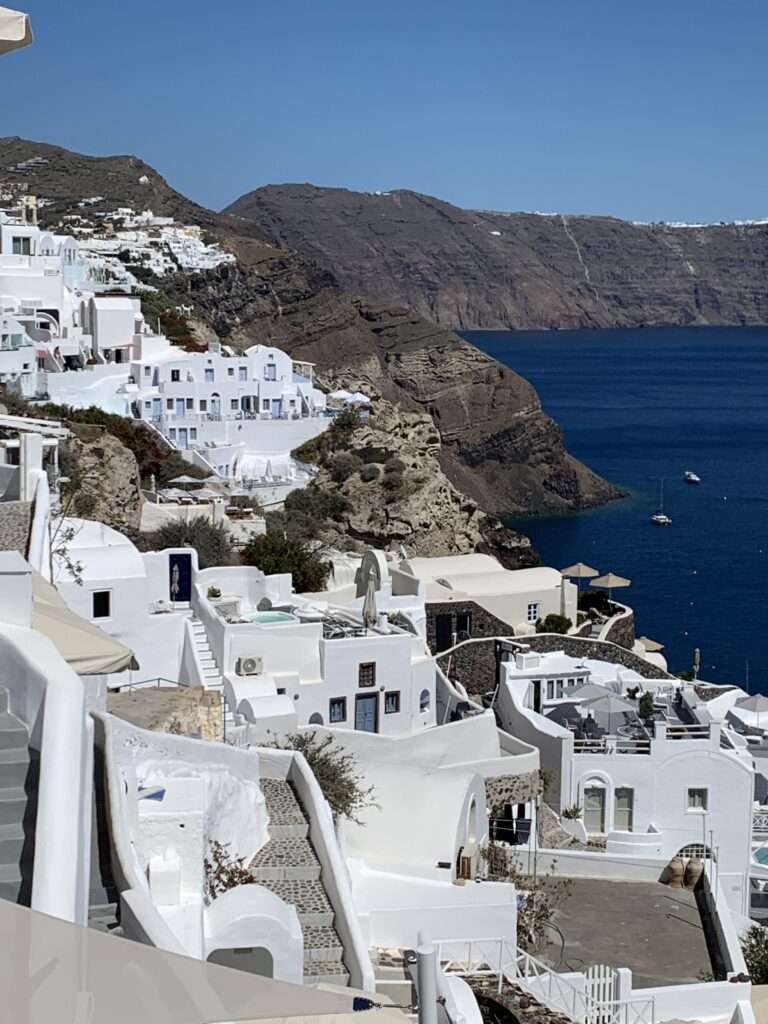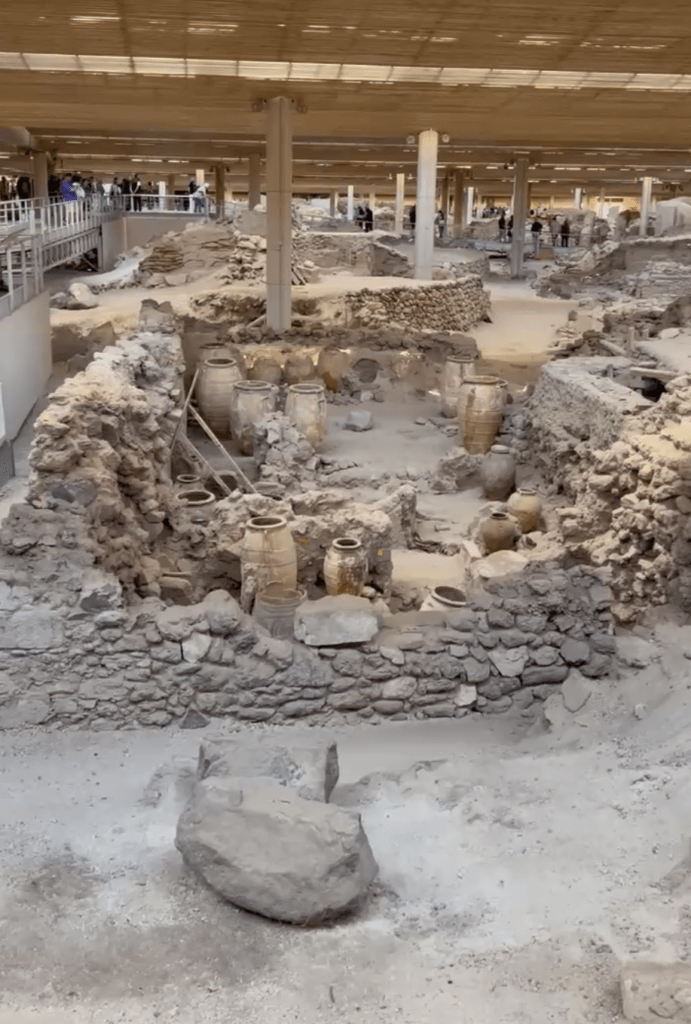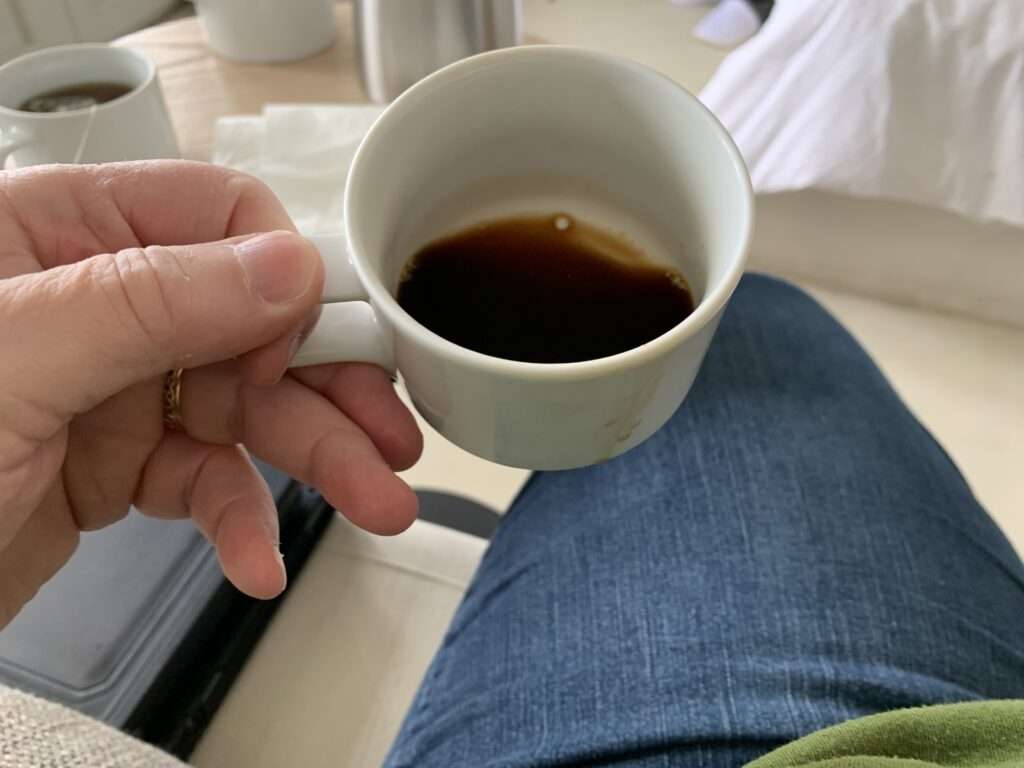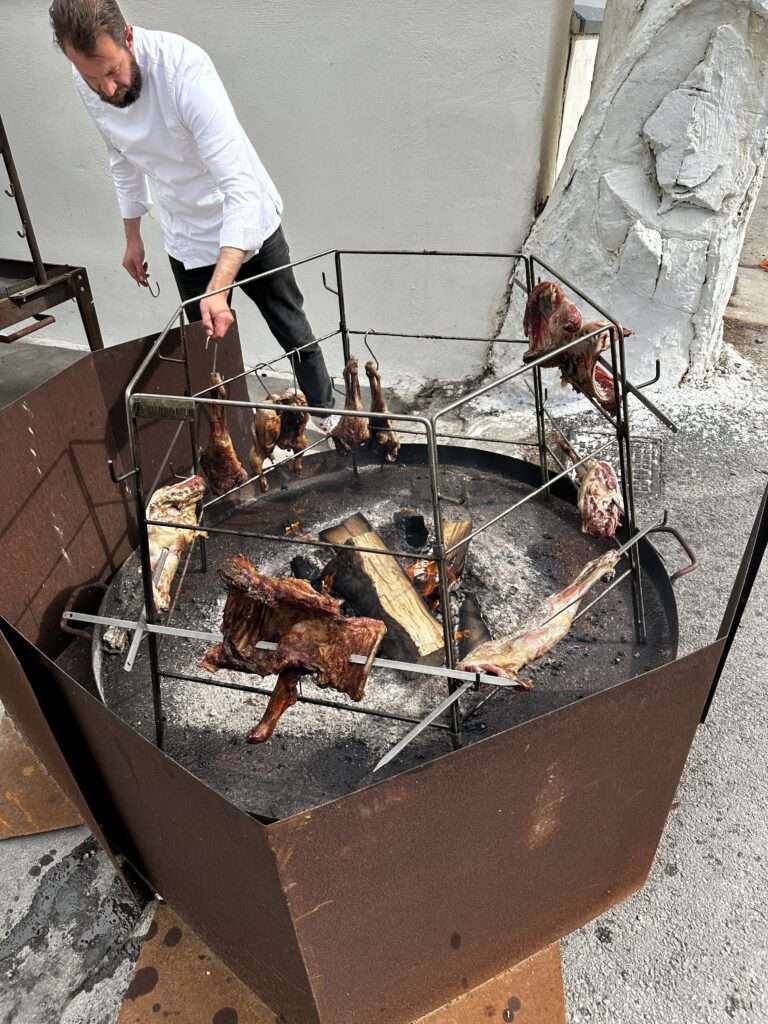
Midway in our Southern Greece trip, in the spring of 2024, we traveled 145 miles from Athens to Santorini via plane. Athens, the capital of Greece, is a cosmopolitan city, and the land of dramatic ruins. Santorini, on the other hand, is an expensive tourist island, considered by many as the jewel of the Greek archipelago with its white-washed houses clinging onto steep cliffs leading to the amazingly blue water of the southern Aegean Sea.
—**—

Our Experience in Satorini
Santorini is one of many islands that make up the remaining caldera rim of a dormant, yet still active volcano. During the Bronze Age, ~3,600 years ago, the volcano erupted and created tsunamis, buried towns in ash, and possibly affected the global climate.
- Some even think this catastrophe also contributed to the demise of the Minoan civilization.

Santorini is now part of the crescent-shaped Caldera. It is a natural beauty, featuring breathtaking views of the Aegean Sea and other islands, crystal clear blue water that is 400 meters deep, and dry, desert landscapes peppered with cactus, imported palm trees, and bushy desert-type vegetation.

We stayed at Enigma Suites in Fira (820 feet from the water and perched on the cliff). Critical to an Easter story below, our hotel was located just off one of the main pedestrian streets in Fira, and just below the main church on the street. There were 8 suites, and each had a balcony view of the Caldera, Aegean Sea, and breathtaking sunsets. Additionally, they had a rooftop bar and restaurant that was not open when we arrived.
The hotel staff worked hard, as it was down 2 flights to the main office, and an additional flight of stairs down to our room. The hotel workers carried our luggage, brought our breakfast to our balcony, and cleaned our rooms which amounted to, over time, damaged knees. I know this because I asked. We appreciated their help, kindness and the attention to our comfort and ease. The front desk people were very helpful and showed us a genuine level of welcome. Definitely worth staying here again and we recommend the hotel; ask for room #2 as it requires the least number of stairs to get to.

Hints + Tricks
Peak tourist times are June – August, so we decided to come in early May, hoping to miss the throngs of tourists that often make long lines, and hot days even hotter. Even so, during our early stay here, 5 cruise ships entered the harbor, and the crowds started to get larger by the day. If you can, arrive early or later than the peak tourist season for a more pleasant stay. But note, too early or too late and the island sort of folds up, so the earliest I would come would be late April.
Santorini was hotter than Athens, and in general receives less rain. So we always carried water with us and put on sunscreen, wore a hat, and a sun-shirt. While there, we did experience an unusual day of rain and thunder, along with some high winds.
While I did brush my teeth with the tap water, we did not drink the local water, we bought water. Later, we were told that the water on the island came from several desalination plants. Another part of bathrooms, is that due to very old plumbing, you cannot flush toilet paper down the toilet; it goes into a lidded garbage can nearby.
Additionally, we noticed the interesting food variations grown in Santorini. Since there is little rain but high winds, they have special low lying and drought tolerant white egg plants, cherry tomatoes, some red but lots of white wine grapes, cucumbers, etc. But the growing season for these are later than we were there, in early summer, so we probably ate imported foods from the mainland.

Around Athens, but especially in Santorini, the “evil eye” icon is found everywhere and endures as an integral part of Greek culture. Essentially, this symbol is meant to deter the wicked energy that a person can transmit to another. It appears on pendants, earrings, and door-stoops.

Many of the old villages were not meant for vehicles. They are often hanging on a cliff with small pathways between buildings. Some we walked were only 3-6 feet wide, clearly walkways built for pedestrians and mules, broken up with many steps, hand-layed cobble stone or rock roads, and often steeply angled, as the land is hilly. Occasionally, we saw mules or donkeys being used to bring construction materials to a site, or goods to a little store, which is a traditional means of transport. Ethical owners who rely on the mules for their work take care of these animals, as they are still the main, and sometimes only, means for the transport of materials.
- For people who live in these villages, we saw many more scooters and motorcycles being used to travel and mules were seen to haul construction material.
- But, in places, these hard working animals were offered as a service to tourists to carry them up and down these pathways. Unfortunately, there are unscrupulous owners, and some tourists and investigators have documented scars and open wounds on these animals, observed mistreatment, and have seen little respite given from the heat for those animals.
- Please consider not partaking of this “service,” but do keep an eye out for their poop.
Culinary Experience
Whereas Athens had a lot of street food, Santorini does not have as much, but they have restaurants all over touristy places, serving some of the same food. In smaller villages there were a variety of foods available, all tasty and hearty, befitting the land and its people.
Breakfast

Part of our stay included breakfast, either in our room (on the balcony of course) or on the rooftop. We ate each day on our balcony, sitting there watching as slowly more cruise ships arrived to overcrowd the space with bodies speaking differing languages, English being the common for communication.
Normally each breakfast consisted of yogurt, fresh fruit, bread, honey, jam, and a salad. Eggs were offered, I think, primarily for tourists.
Drinks

One of the drinks I liked was frappe, an instant coffee mix. I was introduced to it in Athens, and multiple times ordered it in Santorini. Nothing better than sweet, cold coffee to wake you up on a hot day.

We, at least my son and I, also consumed “regular” coffee which was dark, french-pressed liquid. Greeks would add sugar to their coffee, but never milk. Although polite, they looked at me askance when I asked for some cream. Frankly, my stomach would only take a Greek coffee only once a day and the milk really helped tone down the acid.
Anytime we sat down, the very first thing we would order however, was still water, as opposed to sparkling.
Dishes we Ate

Appetizers were great. Above is one we had the first day and it really satisfied the need for sustenance and flavor. The drought tolerant white eggplant is served in Santorini as a pureed eggplant dip, or as eggplant chips dipped in Tzatziki sauce.

Cherry tomatoes are grown in Santorini, and are tasty. They are used in nearly all dishes, as larger tomatoes have to be imported. One traditional dish is tomato fritters with Tzatziki sauce. At another place we received a tomato spread (cherry tomatoes, garlic, olive oil, and seasoning) along with our bread.

Another dip we tried was based on Fava me koukia (aka “fava”) which is fava beans mashed up with a lemon sauce and usually topped with fennel and parsley, but we also saw something called “fava” which was boiled yellow slit peas (grown on the island) cooked with onions, and pureed. It was served in a bowl topped with a few slices of onion, olive oil, and capers.
- The fava grown on the island is a Protected Designation of Origin (PDO)

The Santorini version of the Greek Salad is a bit different, although it has similar ingredients. There are tomatoes, cucumbers, onions, olives, olive oil, sometimes bell peppers, topped with cuts of cheese sprinkled with Greek oregano. However, the cheese was not feta, as Santorini tended to use Hloro (very creamy goat cheese).
Additionally, and this was a great surprise, they added a lot of capers. This is no doubt because it grows everywhere here. Another surprise was the addition of caper leaves to the salad. They tasted like a milder version of the fruit. Finally, the local olives were smaller than what we were served in Athens, so any big ones we assumed were imported to the island.

Pascha (Easter) Celebrations
Santorini, as well as the rest of Greece, is predominantly Greek Orthodox, and has hundreds of temples scattered across the island, some dating to the 11th and 12th centuries. The Church is considered by some more than a place of worship, for it is argued, during the many occupations Greece has endured, it was the Church that critically worked to preserve the Greek national identity by fostering efforts to maintain the language, culture and customs. Some people however, actually believe this viewpoint is just a national myth, that simply sounds good and promotes the Church.
Regardelss, the big holy week this year was from 29 April through 4 May, with Easter celebrated on 5 May. We happened to arrive at Santorini on the 4th, in time to experience and taste some of the festivities and traditions. Not being a Greek Orthodox person, I have relied on many websites to fill in my knowledge gaps (1, 2, 3).
Thursday, 2 May

Melitinia is a traditional sweet treat, made during special occasions, such as Easter. On Thursday this and other pastries and cookies are made. Melitinia, an unsalted mizithra cheese pastry, is blended with sugar and mastic powder. It is soft, creamy and great with coffee or tea. I was told Erotokritos Bakery in Santorini is where to get the most authentic version, but we picked up ours at the hotel’s front desk.
- Mastic is a yellowish, tree resin that shows up everywhere in Greece, in honey and liqueurs, from gum to pastries, in breads and cheeses. To me it is an unusual flavor, not particularly pleasant, more like an herbal evergreen with a hint of licorice.
- It comes from a special variety of the mastic tree, and is only grown on the Greek island of Chios.

On this day families gather to make Kokkina avga, or hard boiled eggs dyed to a deep red, symbolizing the “blood of Christ.” There are packaged, non-toxic red dye, or some swear by using yellow onion skins and vinegar. The eggs are shared, becoming a token of goodwill between loved ones.
But also there is a game (tsougrisma) involved where each person holds an egg, then they are hit together. The person doing the tapping says Christos anesti (Christ has risen) and the one whose egg is being tapped replies Alithos anesti (indeed He has). One by one, the owners of cracked eggs are excluded, until there are just two people left. Whoever’s egg does not crack is the winner, and should have good luck for the year.
There were plenty of eggs left on Easter so my spouse and I and my son and his girlfriend played the game. Alicia won, and I ate a boiled egg.
Friday, 3 May

The Procession of the Epitaph is a tradition that occurs on this day in all the small villages. But Pyrgos Kallistis is special in their version of the celebration, because part of what they do involved the lighting of many, many candles. So, on Monday, 6 May, well after the event we took a tour of the island and visited many places including Pyrgos.
This is a village built on a very steep, hilly area exposed to the winds. As such it is very much a pedestrian town. We were told that on the evening, just before leaving for the Procession, thousands of cans are lined along village sidewalks, walls and on rooftops. These tin cans are filled with wax or fat, wicked, and lit so that during the evening and night hours the village is outlined with glowing, and shimmering candles. We did not get to see the lighting, but did see the “after the fact” burnt out cans.
Saturday, 4 May
We arrived from Athens, and as expected landing a plane on an island is exciting, and a bit turbulent with quick breaking. As we were leaving the plane we were optionally given a long white candle, for upcoming festivals. Likewise, when we entered our hotel room, we had two (better quality) long white candles on the dresser.
After attending church, the Greek family would gather around the table and eat a traditional meal including a special soup to signify the end of their fast. In some of the villages, a huge feast is prepared in the central square.
Traditionally, at midnight, families would gather in their local churches to receive the “Holy Flame.” The priest announces the “resurrection of Christ,” and the “Holy Flame” symbolizes life victorious over death. Then single flame is used, passed from hand to hand, to light all the candles in celebration of the resurrection. Then often this light is carefully brought home to light other candles.
But this day was a cold and very blustery day in Santorini, with winds hitting upwards of 25mph, and there was talk of not lighting the candles that night due to the fire hazard this might bring. So we went to sleep instead, thinking the festivities would be shut down.
Sunday, 5 May
But hours later, at midnight, we were abruptly awakened to the sounds of “boom, boom, boom” and ran outside to the balcony — Thunder? Gunfire? The volcano? No it was the amazing fireworks celebrating the “resurrection of Christ.” There were fireworks being set off right above our heads at the Church, and elsewhere on the Island that we could see from our balcony.

Whole lambs, sometimes cut parts, are roasted over a fire pit for several hours, before being taken home for the family feast. Eating meaty delicacies like spit-roasted lamb and goat on Sunday is part of the traditional meal.
Meals I Especially Liked

Salads were mainly the traditional Greek salad that I have written about previously, so when I had the opportunity for something that still contained native Greek produce, this Amphora Salad hit the mark. Greece has cultivated walnut trees dating back more than 2,500 years BC. Now they produce ~1200 tons annually, in small holdings. They also grow oranges, and arugula is native to the Mediterranean so has been grown since ancient times.

We often found we had no room for dessert, absolutely no room. Between appetizers, small dishes, and main dishes the food just became too much. But this cake was wonderful, and we finished it off readily enough.

Surprisingly, there were lots of vegetarian, and even vegan options, everywhere we went. This dish was amazingly simple and very tasteful.
My Thoughts
I am glad we went to Santorini, and am pleased that we (accidentally) came during festivities, for they gave a focus to our visit and allowed us to join in community with locals.
To me, the story of Santorini is not in the tourist areas. The story of the land and people is in the little villages off the beaten path with small rock and cobblestone alleys, twisting and turning 3 foot wide walkways, and small whitewashed stone and plaster buildings.
In one place, I took a break from all the walking to have a vanilla milkshake, and that little break allowed an opening for a local woman and her dog to stop and talk with me. She told me, with a sweeping arm, “all this” waving to the land from the village to the sea, “used to be open land.” With sadness in her face and a bit of anger in her voice she went on, “and now it is broken, with housing and AirBnBs. Turns out she had a family home on the island, and now she visits every year during Easter joining the family for celebrations. She was sad for the loss, mad about the change, yet kindly did not blame me as a tourist. For her, the land was family and a part of her identity that was changing, against her will, to accommodate modernity.
I think if anyone is going to Greece, consider adding this to the list of islands to visit. The hotel was perfect, the land dry and steeply hilly, the vegetation sparse, the island’s food was for me hit and miss, but most especially its location and its people were extraordinary and will always be a memory I hold dear.
—Patty
—**—
At 1025 on 26 May, the Facebook post of this page has 100 likes and 3 shares, and is growing. One of our most shared page so far. Thank you.